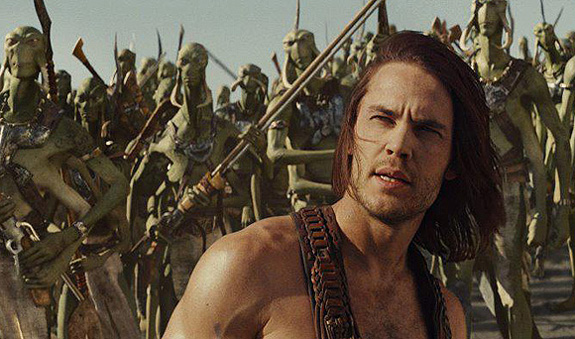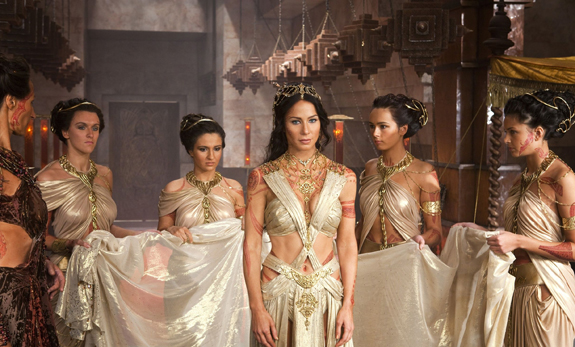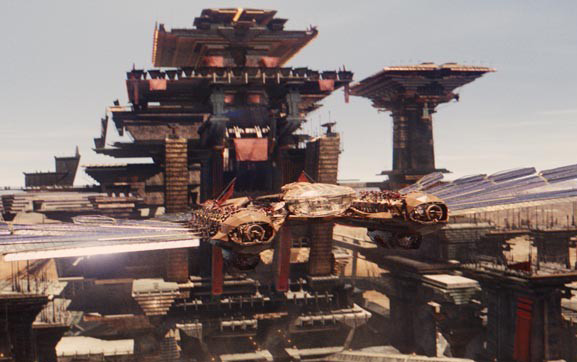It’s pretty well established that adaptations of popular literature to the big screen is a hard business, and today’s example is no exception. In fact it is the epitome of how difficult it is. In my first article of this series, I detailed the translation of Stephen King’s The Shining, which was a case where a brilliant filmmaker dramatically altered a brilliant piece of writing and came out with something equally as brilliant. In my second article, I covered The Road, an example of filmmakers sticking closely to the text of Cormac McCarthy’s masterpiece and coming up with something that was just okay. Now I’m going to tell you about a movie adaptation of a classic novel that proved to be an outright disaster, at least at the box office. This of course is the failed big screen adaptation of Edgar Rice Burroughs’ early twentieth century classic, John Carter of Mars. John Carter (2012) was Walt Disney Pictures attempt to jump start a new big screen sci-fi franchise, one which already had a nearly hundred year long legacy behind it in literary circles, but once the movie made it to theaters, it was sadly met with indifference by critics and audiences, which did not bode well after Disney had spent a quarter of a billion dollars making the film. Some have argued that the reason behind John Carter’s box office failure is because it had long become irrelevant over the many decades since the series was first published and that all of its many influences have since overtaken the original in notoriety. In this article, I will look at how the movie stands up to the original novel, and see exactly if it was a problem with the translation or if the original story was too out of date to become a hit with modern audiences again.
Although the story of John Carter of Mars may not be as fresh in everyone’s minds today, its influence has been widespread in both literature and in cinema. The story first appeared in serial publications all the way back in 1912, written by an imaginative young American author named Edgar Rice Burroughs. Burroughs’ serial, then titled Under the Moons of Mars, detailed the adventures of Sergeant John Carter, a former Confederate soldier who is magically transported to the planet Mars while on the run in the deserts of Arizona. Once there, he learns that his strength and agility are increased ten fold because of Mars’ lower gravity and thinner atmosphere. His special abilities catch the attention of a tribe of tall, green-skinned warriors known as Tharks, who quickly adopt Carter into their clan. Over time he learns their language and gains their trust, especially with regards to the Thark chieftain Tars Tarkas and his estranged daughter Sola. In time he learns more about the different cultures of Mars, which the Martians call Barsoom. And John Carter learns that Barsoom is just barely clinging on to life, with the oceans dried up and only two major cities left on the entire planet, both of which are entangled in a civil war. One is a city of scientific research known as Helium and the other is a mobile scavenger city called Zodanga. The Tharks are a nomadic tribe who avoid contact with the red skinned human-like residents of the two cities, but conflict finds them when a Helium expedition team runs into a Thark encampment, which brings the Princess Dejah Thoris into John Carter’s life and soon brings the outsider into this global conflict.
“When I saw you, I believed it was a sign… that something new can come into this world.”
A lot of John Carter’s plot may seem very familiar if your familiar with a lot of sci-if tropes and superhero origins. But, it should be noted that John Carter of Mars actually predates most of what we know of science fiction today, so if anything what time has actually done to make people forget how revolutionary a piece of literature it was. Along with his contemporaries across the pond, H.G. Welles and Jules Verne, Edgar Rice Burroughs was inventing what we know as the Science Fiction genre. But while Verne was celebrating wonders of science in fantasy, and Welles was using science as a basis for social commentary and cautionary tales, Burroughs’ was using science as a basis for swashbuckling adventures. John Carter was mostly inspired by other larger than life heroes of the era like Zorro and Davy Crockett, only his adventures were taken into a more celestial setting, giving rise to new possibilities in adventure writing. Burroughs would write 12 novels in total set on the world Barsoom, detailing the exploits of John Carter and his offspring. Not only that, but Burroughs also put so much effort and detail into his novel that he even crafted a dictionary detailing the rich vocabulary of Barsoom and its many cultures, a concept authors like J.R.R. Tolkien would later adopt through appendices and side stories connected to their novels. Because of the enormous success of the John Carter books, there are decades worth of different works of literature and cinema that have either been influenced or have outright copied it over the years. Of course, the similarities to the origin of Superman are pretty obvious, swapping out a hero sent from Earth with a hero sent from the planet Krypton. But, there are also elements of John Carter’s story found in everything from Star Wars, to He-Man, to even James Cameron’s Avatar (2009). So, why did it take so long for John Carter to make it to the big screen himself?
For the most part, it was just several cases of bad timing and filmmakers not finding the right angle on the story. Several attempts were made through the years to bring John Carter to the big screen. Warner Brothers worked with Edgar Rice Burroughs directly to bring an animated version of the character to life in a project that would’ve predated Disney’s Snow White and the Seven Dwarves (1937) as the first full length animated feature. Sadly, the project never took off, mainly due to budget concerns and all that remains of the project is demo reel recently discovered in the Edgar Rice Burroughs archives in Tarzana, California. Live action versions surfaced off and on over the years, including one in the 80’s directed by Die Hard (1988) helmer John McTiernan and starring Tom Cruise as the title character. Sadly, this two never gained traction. Disney stepped in twice over the years, once in the 70’s and again in the 2000’s to get a John Carter movie made, and it wasn’t until the second time around that the film finally gained footing. Part of Disney’s confidence in the project came from their successful collaboration with the Burroughs estate, adapting the author’s other popular character Tarzan into an animated film. And with CGI becoming much more reliable, it seemed more possible to bring Burroughs’ vision of Barsoom to reality, magnificent creatures and all. To undertake the adaptation, Disney gave directing duties to Andrew Stanton, an award winning animation director from Pixar, who had never directed a live action feature before. It was an unusual choice, but Stanton was a proven storyteller, with his enormously successful Finding Nemo (2003) and Wall-E (2008) earning huge raves. But, as was soon apparent, bringing John Carter to the big screen proved to be more difficult endeavor than anyone anticipated, and there is no easy answer as to why.
“I tell you truly, John Carter of Earth, there are no Gates of Iss. They are not real.”
Opening in Spring 2012, John Carter struggled immediately at the box office, falling way short of it’s production budget and causing Disney to declare a huge shortfall for their company profits that year, leading to a write off. And though part of the failure of the film falls upon the quality of the film itself, it’s not entirely to blame. John Carter was a nightmare for Disney’s marketing department, leading to several title changes, until ultimately doing away with the “of Mars” moniker and just labeling it with the very bland sounding John Carter. While the title didn’t help much, the main struggle was the fact that there was nothing here to distinguish John Carter from every other sci-fi film of the last half-century, which is ironic given that the John Carter novels are what introduced the world to the concept of science fiction. As a result, John Carter became an unfortunate victim of it’s own legacy. Too much time had come between the introduction of the character and his eventual appearance on the big screen, with the movie ultimately being released on the character’s centennial anniversary in 2012. But, did the fault come from an outdated story-line? Frankly, having read the first book on which this movie is based, I was astonished how little about it was dated. Sure, some of the morals and racial undertones don’t quite fit today’s standards, but Edgar Rice Burroughs’ writing style is so timeless and easily comprehensible that it can be just as easily enjoyed today as it was when it was published 100 years ago. The main problem is not the text, but the fact that it’s become too absorbed into everything else in science fiction, making it far too familiar to newer audiences. Disney could have done something interesting with the text and make John Carter either a uniquely artistic interpretation of the source, or give the story a very modern twist that could help set it apart. Instead, they went the safe route, and basically rip off all the other properties that John Carter had inspired, creating a mobius strip of mediocrity.
“When I was little and we would look up at the stars, you would tell me of heroes whose glory was written in the sky.”
One big thing that was lost in translation between the book and the film was actually the character of John Carter himself. In Burroughs’ original novels, we are treated to a first hand account from the main character himself, helping to put us right inside the mind of John Carter on his journey. By doing this, Burroughs perfectly illustrates the wonders of Barsoom by putting the reader into the mind of the outsider, experiencing this new world first hand. We also get to know the man John Carter much better this way, seeing him as a somewhat arrogant but still very courageous and cunning hero. In the movie, that first person experience is minimized. In the movie, Carter (played by Taylor Kitsch) recounts his story through his last will and testament to his beneficiary, Edgar Rice Burroughs (played in the film by Daryl Sabara). It’s weird to see Burroughs himself depicted as a character in a movie based on his own creation, but it’s actually something they adapted correctly from the book. From there, the movie has Burroughs reading the account of Carter’s journey, but once the flashback begins, the movie begins to fragment, moving away from the first person perspective. This is unfortunately where the movie falters because by cutting away from Carter’s story to tell the larger political plot across Barsoom, we ultimately loose focus on the character. And unfortunately, Taylor Kitsch is not a good enough actor to fill that charisma hole and make John Carter interesting. Instead, he’s purely there to look good in the costume, which is sadly true for the rest of the cast. Everyone, including some good actors in the cast like Dominic West, Mark Strong, and Bryan Cranston are purely in costume drama mode and hardly ever make an impression in the movie. The only characters with a little personality in the film are the CGI animated Tharks, especially Tars Tarkas (with the voice of Willem Dafoe) who is by far the best realized character in the movie. But, by trying to remove the focus off of the main hero, and tell the story in a more standardized way, it robs a little power away from John Carter’s character in the process.
A lot of the remaining problems with the movie, besides the bad timing of it’s release and the loss of focus on his character, is the fact that there is no passion behind it. It seems like Disney put the film into production purely as an obligation, and the end result is a paint by numbers approach to epic film-making. Andrew Stanton is a fine filmmaker and a brilliant storyteller, but he was clearly out of his element here. Unfortunately, he was tasked with adapting a story that modern audiences were unfamiliar with, and yet also had this monumental legacy behind it. Too much pressure was put upon his shoulders and all he could do was just ride out the storm. Unfortunately, by just checking off the list of familiar story tropes, he was left with a film that lacked any resonance. At best, he made a movie that looked pretty, but had no memorable dialogue, no distinguishable characters, and no sense of adventure. But the task shouldn’t have been dealt with so lazily by Disney. Burroughs’ novels are tailor made for the big screen and the only thing that was holding them back was the fact that technology couldn’t fully present Barsoom in the way it needed to be seen. Disney held up that end, but they didn’t allow the story to define itself. A large reason for that is because too many science-fiction films today have become action packed extravaganzas, and Disney didn’t want their film to feel too different. Therefore, much of John Carter is filled with needless action set pieces that don’t advance the story in any way. Only a standout scene in an arena where Carter fights Martian White Apes actually stands out, and that’s mainly because it comes straight from the source; and has of course been imitated in countless other sci-fi stories (the Rancor pit in Return of the Jedi for example). Couple this with a lack of character development, and you’ve got a movie that is neither immersive nor engaging. It sadly becomes a cliff notes version of Burroughs’ original story, stripped down of actual originality in order to appeal to all audiences, and appealing to none in the end.
“Did I not tell you he could jump!”
But, does this reflect badly on the original novels themselves? I don’t believe so. John Carter of Mars has been around for over a hundred years now and will continue to stick around long after. And the movie itself could have been a lot worse than it is. It doesn’t exploit the novels in a bad way; it’s not even that bad of a film overall. It’s just a disappointment in the end. A great film could have come out of this had a more creative vision been behind it. Sadly, John Carter could not escape the fact that too many years had passed the story by, and everything that it had pioneered had already become normalized in other works of science fiction. By the time this movie came out, it had nothing original left to add. That’s not to say something new and interesting could have been done with it. By playing it safe, Disney spoiled any chance of actually bringing John Carter back to relevance again in it’s second century of existence. What I think they should of done is take the same route they took with Edgar Rice Burroughs’ other famous creation, Tarzan, and make an animated feature based on John Carter. It probably would have retained more of Burroughs’ original vision of the character and the world he inhabits had they chosen that medium, but working in live action with the tools we have now is not unreasonable either. Sadly, Disney was one and done with John Carter; scrapping plans for a trilogy and letting the rights revert back to the Burroughs’ estate, who can shop the story out to other studios now. Still, it is admirable that Disney allowed for the movie to be made, given the long wait for the character. Hopefully, we’ll get a better John Carter of Mars movie in the future. For now, you can find it in any book store, and the stories remarkably hold up to today’s standards. But, what this proves is that even earnest adaptations can go astray and it may be as a result of not knowing how to handle the story right, or trying to deal with it too delicately for it’s own good. Time was not on John Carter‘s side, but a failed movie shouldn’t be an indicator of a flawed story. John Carter still stands as a legend and hopefully his time will come again.




